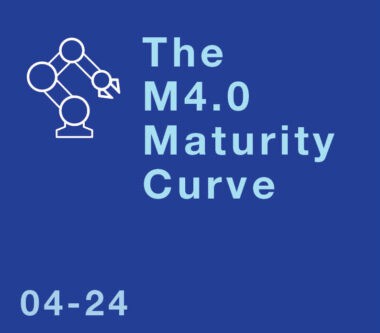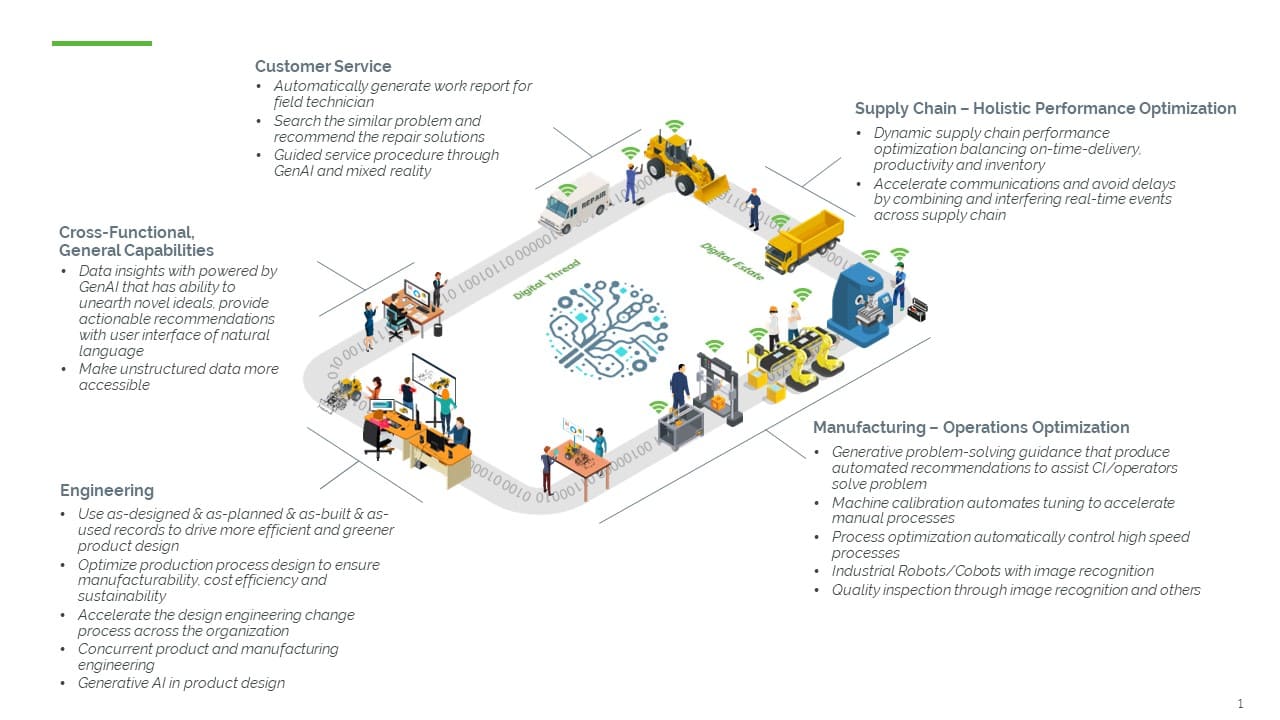GenAI Ushers Human-Like Intelligence in Manufacturing

Catalyzing Digital Maturity with Generative AI: Democratizing Data Analysis, Automation, and Problem-Solving in Manufacturing

TAKEAWAYS:
● Generative AI stands as a transformative technology poised to democratize data analysis, reasoning, and automation throughout the manufacturing industry’s value chain.
● Leveraging Retrieval Augmented Generation to enhance foundational models represents an optimal technique for beginning to harness GenAI’s value.
● Manufacturers should evaluate digital maturity and initiate pilot-testing applications to identify high-impact, feasible business challenges while establishing an interconnected and contextualized data foundation.
The AI Wave in the Manufacturing Industry
The AI wave, and specifically, Generative AI (GenAI), is poised to disrupt manufacturing. GenAI’s greatest strength lays in democratizing the power of data analysis and automation through a reasoning engine and a natural language interface. A 2023 BCG survey of 1,800 manufacturing executives found that GenAI is the technology with the most disruptive potential1. With the power of large data analysis, manufacturers can optimize value systematically and dynamically — a feat of “mission impossible” proportions today.
AI Categories and Capabilities

Figure 1: AI Types and Capabilities
In the last few years, classical machine learning has been broadly implemented in manufacturing to predict machine failures, classify defects, identify process outliers in machine behavior and product quality, and even to autonomously adjust machine parameters to optimize quality and throughput. While classical machine learning has been a staple, the exploration and implementation of GenAI’s capabilities in this sector are just beginning to unfold. Both classical machine learning and GenAI are valuable for different reasons. GenAI revolutionizes data analytics by pre-training on vast unstructured datasets, making it possible to alter the way that prediction, classification, and clustering are calculated in classical machine learning models. Meanwhile, GenAI’s natural language processing and code generation/interpretation capabilities allow business professionals to access complex data analysis without needing programing or data science expertise. The development of multimodal foundation models is unlocking capabilities to turn not only text but also audio, images, and video into dynamically generated insights in the hands of frontline workers. Mexican workers can benefit from the problem-solving experiences of their Asian and Polish counterparts, aided by an intelligent agent that offers summarized solutions and specific action recommendations based on insights from these regions. Industrial engineers can scan the timetable or Standard Operating Procedures (SOP) on paper to generate digital SOP and work instructions and associate them with the product and process design.
AI and Generative AI Use Cases for Manufacturing
GenAI’s adoption will democratize access to vast reservoirs of structured and unstructured knowledge bases, enable large-scale data analysis, and provide powerful reasoning engines and complex problem-solving capabilities to all individuals, regardless of their technical background. Ultimately, manufacturers can use these capabilities to mimic the adaptive problem-solving capabilities of humans, by learning behavioral patterns from past human and machine experiences. Gartner refers to this as Actionable AI and sees it as one of the top innovative technology trends for manufacturing operations leaders4.

Figure 2: Classical ML and Generative AI use cases across value chain2
Data Insights: Empowering the Entire Value Chain
From engineers to shop floor personnel, GenAI is revolutionizing data analysis. It scales insights from both internal and external, particularly unstructured, data sources — enriching advanced analytics with foundational model-generated insights. GenAI’s true innovation in data insights lies in its ability to unearth novel ideas, offer an unlimited scope to dissect data from multiple perspectives, and provide actionable recommendations — not just diagnostics — all in real-time.
Operations Optimization: A New Paradigm for Operations Leaders, Frontline Workers, and Continuous Improvement (CI) Leader
GenAI introduces closed-loop asset optimization by supplementing programmable logic controller (PLC) inputs with a broader spectrum of data points like vibrations, temperature, and pressure (typically captured from IoT sensors). As a result, operations leaders can leverage GenAI to pinpoint machine optimization opportunities. Furthermore, frontline workers and continuous improvement leaders can consult GenAI systems for advice on specific operational challenges — eliminate bottleneck and non-value-added activities — transforming GenAI into a ubiquitous and invaluable partner in continuous improvement.
Product and Process Design Optimization: For Innovative Product and Manufacturing Engineers
In addition to generative design, product engineers can utilize GenAI for product design by integrating multifaceted data from as-designed and as-built and as-used records, leading to smarter and more efficient design choices. Manufacturing engineers can employ GenAI for process design optimization, ensuring that manufacturability, cost-efficiency, and sustainability are embedded at the very heart of production processes. Through GenAI, design principles are not just informed by data but are fundamentally driven by the most advanced insights available. GenAI can also help accelerate the collaboration and engineering change process across the organization by leveraging contextual information from otherwise untapped information sources like historical paper-based designs, and by securing inputs from a globally distributed design team in their natural languages.
Holistic Performance Optimization: Strategizing for Supply Chain and Operations Leaders
Supply chain and operations leaders have long grappled with the complex challenge of dynamic performance management, balancing safety, quality, delivery, productivity, and inventory. GenAI excels in parsing large, complex, and interlinked datasets, learning from historical patterns to offer insights and recommendations for emerging issues, equipping leaders with a robust tool for strategic decision-making. By combing real-time updates (both internal and external; for example, weather and frequently changing geo-political landscape) and inferring the impact to shipment updates as communicated via email from suppliers, GenAI copilots can accelerate communication across the supply chain thereby shortening delays and making the operations more responsive and resilient.
The Approach for GenAI in Manufacturing
In theory, industrial companies can approach Generative AI in three ways: training their proprietary foundation model, fine-tuning an existing foundation model, or enhancing an existing model via prompt engineering and Retrieval Augmented Generation (RAG). Prompt engineering refers to the process of designing, refining, and optimizing input prompts to guide a generative AI model toward producing desired outputs3. RAG is an architecture that augments the capabilities of a Large Language Model (LLM) by adding an information retrieval system that provides grounding data. In practice, training proprietary models and fine-turning foundation models are both resource intensive and can quickly run up costs in the of tens of millions of dollars — leaving most manufacturers with very unclear ROI. RAG alongside prompt engineering is the least expensive and quickest method. It also offers greater transparency as it can refer to sources, making it an ideal starting point for companies looking to explore GenAI technology and validate use cases.
With foundational models and RAG frameworks improving with strong reasoning capabilities and tools, we can expect the adoption of GenAI to scale quickly — roles across the value chain will be enabled by one or multiple copilots. In fact, the simplest RAG application can be built with as little as “five lines of code”5. However, regardless of the techniques used, GenAI outputs are only as good and reliable as their inputs — a contextualized, interconnected data foundation is critical. The adage, “garbage in, garbage out” still holds true in the GenAI era, and garbage-in can lead to perilous AI inaccuracies. The data foundation needs to allow GenAI applications to understand the context around the data. For example, the OT data from PLCs is usually tag data displaying vibration and temperature but does not have the context of what asset the PLC is in, which plant, line, material, or operation it is associated with.
“The development of multimodal foundation models is unlocking capabilities to turn not only text but also audio, images, and video into dynamically generated insights in the hands of frontline workers.”
Building a GenAI app for product design and manufacturing engineers regarding the optimal manufacturability (cost, quality, and delivery) requires an interconnected data foundation that includes the as-designed, as-planned, as-built, and as-used records of the product through its product life cycle. The opportunity for a product designer to design a better product lies in mining the actual history and experience through data gathered from users, and the IT and OT systems that span the engineering, manufacturing engineering, production execution and field services processes.
Start by Getting Your Data House in Order
Technology is a key pillar in the digital maturity journey, and RAG and prompt engineering are the first steps in understanding how GenAI can impact your business. A GenAI implementation should start with evaluating current digital maturity and focusing on the business outcome, starting small with high impact use cases, followed by an intentional plan to rapidly scale implementation and adoption of validated outcomes. As data privacy and security are top-of-mind in assessing new technologies, it is important to understand the data privacy policies of LLM service providers. From a technical perspective, the most crucial and foundational step is to build a contextualized, interconnected data foundation

Figure 3: Illustrative architecture of applied AI
A four-layer framework illustrates the GenAI data foundation approach:
- The first layer is the hardware computing infrastructure layer.
- The second layer is the data foundation layer, which manages the engineering, operations, supply chain and financial activities and provides the domain-specific data, like real-time engineering and manufacturing information systems (IT), and operational technology (OT) like equipment, sensors, tools, and quality verification systems. This is where ERP, PLM and MES, play a role as the authoritative sources of business data, as well as an IIoT platform like PTC ThingWorx, play a role to get IT, OT and engineering technology data aligned and contextualized.
- The third layer is the AI technology layer and includes machine learning models, GenAI foundation models, orchestration services, etc. Examples of these include Azure OpenAI Service and Microsoft Copilot Studio for AI.
- The fourth layer is the applications layer, where the AI capabilities are applied to solve specific business problems, either as standalone applications or a plug-in of legacy applications.
GenAI represents a transformative opportunity for the manufacturing industry, poised to revolutionize data analysis, automation, and problem solving. Per World Economic Forum, GenAI is expected to add between $2.6 and $4.4 trillion in annual value to the global economy – nearly a quarter of which could be productivity improvements of up to two times and task automations of nearly 70% across manufacturing and supply chain-related activities6. Its potential to empower a wide range of the value chain is immense but realizing this potential hinges on high impact use cases and building a unified, contextualized, interconnected data foundation. We are just beginning to explore GenAI’s vast possibilities. Therefore, we encourage manufacturing companies to pull together a list of your most urgent, impactful business problems that require intensive data collection, validate the feasibility of the AI technology like RAG, and start with building your data foundation leveraging technologies like an IIoT platform and PLM. M
About the Authors:

Amol Adgaonkar is a Senior Director within the Worldwide Manufacturing & Mobility Industry team at Microsoft

Gonzalo Chavez is a Senior Analyst in Market Development, IoT at PTC

Howard Heppelmann is Divisional Vice President and General Manager of PTC’s ThingWorx IoT Solutions business segment

Alex Lemken is the Director of AI and Applied Analytics at PTC

James Zhang is the Vice President of Market Development, IoT at PTC
Appendix
1. BCG, December 2023 https://www.bcg.com/publications/2023/gen-ai-role-in-factory-of-future
2. Microsoft Cloud for Manufacturing, https://www.microsoft.com/en-us/industry/manufacturing/microsoft-cloud-for-manufacturing
3. The economic potential of generative AI. McKinsey. June 2023.
4. Top Innovative Technology Trends for Manufacturing Operations Leaders. Gartner. Nov 2023.
5. https://docs.llamaindex.ai/en/latest/getting_started/starter_example.html. LlamaIndex Starter Example.
6. Global Lighthouse Network: Adopting AI at Speed and Scale. World Economic Forum. Dec 2023